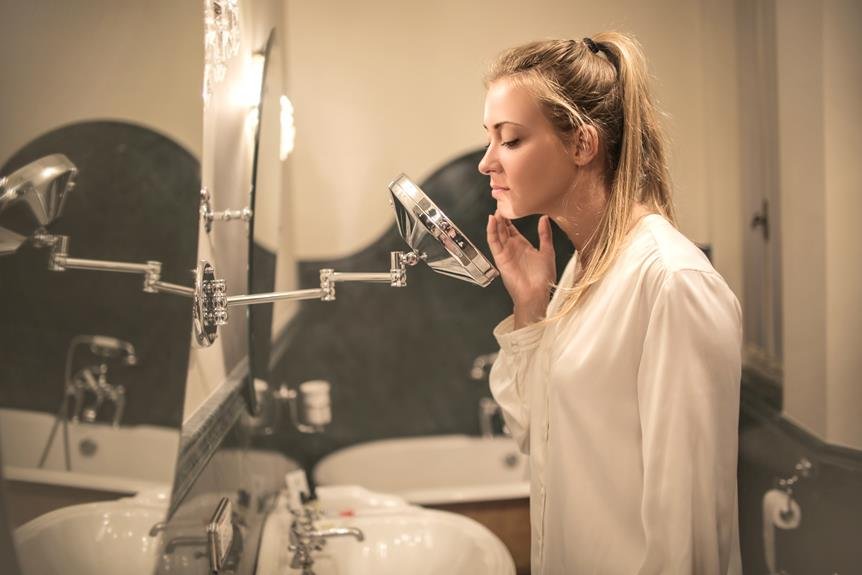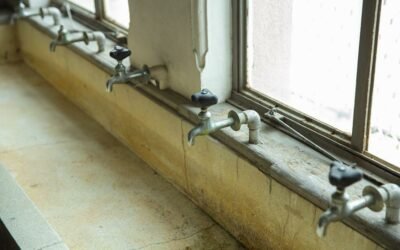Did you know that mold exposure could be causing your acne breakouts?
In this article, we will explore the connection between mold and acne and how mold can trigger those pesky pimples on your skin.
We will also discuss common symptoms of mold-induced acne and how to prevent mold growth to reduce breakouts.
If you're struggling with acne and suspect mold as the culprit, seek professional help to tackle this issue head-on.
Key Takeaways
- Limited research suggests a potential link between mold exposure and acne development or worsening.
- Mold exposure can stimulate sebaceous glands to produce more sebum, contributing to acne.
- Mold exposure weakens the skin's protective barrier, making it more susceptible to acne-causing factors.
- Seeking professional help from dermatologists and environmental specialists can help diagnose and treat mold-related acne, as well as address the root cause of mold growth.
The Connection Between Mold and Acne
If you're wondering about the link between mold and acne, it's important to understand the potential connection between these two factors. While research on this topic is still limited, there's evidence to suggest that mold exposure may contribute to the development or worsening of acne.
Mold, a type of fungus, releases spores into the air which can be inhaled or come into contact with the skin. These spores contain allergens and irritants that can trigger inflammation in the body, including the skin. Inflammation plays a key role in the development of acne, as it can lead to increased sebum production and clogged pores.
Additionally, mold exposure has been associated with weakened immune function, which may further exacerbate acne symptoms. It's important to note that individual susceptibility to mold and its effects on the skin may vary. If you suspect mold exposure as a potential cause of your acne, it's recommended to consult a dermatologist for a thorough evaluation and appropriate treatment.
Further research is needed to fully understand the relationship between mold and acne, but taking steps to reduce mold exposure, such as keeping indoor spaces well-ventilated and free of moisture, may be beneficial for overall skin health.
How Mold Exposure Triggers Acne Breakouts
Mold exposure can trigger acne breakouts by causing inflammation and increasing sebum production. When you're exposed to mold, the spores can irritate your skin and lead to an inflammatory response. This inflammation can disrupt the normal functioning of your skin cells, leading to the formation of acne lesions.
Here are five ways mold exposure can contribute to acne breakouts:
- Increased sebum production: Mold exposure can stimulate the sebaceous glands in your skin to produce more sebum, the oily substance that can clog pores and contribute to the development of acne.
- Bacterial growth: Mold can create an environment that promotes the growth of bacteria on your skin. These bacteria, such as Propionibacterium acnes, can contribute to the formation of acne.
- Impaired skin barrier: Mold exposure can weaken the protective barrier of your skin, making it more susceptible to acne-causing factors such as bacteria, dirt, and oil.
- Allergic reactions: Some individuals may be allergic to mold, and an allergic reaction can trigger an inflammatory response in the skin, leading to acne breakouts.
- Stress response: Mold exposure can be stressful for some individuals, and stress has been linked to acne breakouts. Stress hormones can increase sebum production and inflammation, exacerbating acne symptoms.
Understanding how mold exposure triggers acne breakouts can help you take appropriate steps to prevent and manage acne when faced with mold-related issues.
Common Symptoms of Mold-Induced Acne
Experiencing mold-induced acne can result in a range of common symptoms that are important to recognize. While acne is typically associated with hormonal imbalances or poor skincare habits, mold exposure can also contribute to the development of acne.
One of the common symptoms of mold-induced acne is the appearance of small, red, inflamed bumps on the skin. These bumps may be accompanied by itching and discomfort. Additionally, mold-induced acne may present as persistent breakouts that don't respond to typical acne treatments. This is because the underlying cause of the acne isn't addressed, leading to frustration and difficulty in managing the condition.
Other symptoms may include increased skin sensitivity, dryness, and flakiness. It's important to note that these symptoms may vary in severity depending on the individual's sensitivity to mold and the extent of exposure.
If you suspect that mold may be contributing to your acne, it's recommended to seek medical advice and consider professional mold remediation to improve your skin condition.
Preventing Mold Growth to Reduce Acne
To reduce acne caused by mold, take proactive steps to prevent mold growth in your environment. Mold can contribute to acne breakouts by clogging pores and causing inflammation.
By implementing the following strategies, you can create a mold-free environment and potentially reduce the occurrence of acne:
- Control humidity levels: Keep indoor humidity below 50% to discourage mold growth. Use dehumidifiers or air conditioners in areas prone to moisture, such as bathrooms and basements.
- Fix leaks promptly: Address any water leaks or plumbing issues immediately to prevent mold from thriving in damp areas.
- Improve ventilation: Ensure proper airflow in your home by opening windows, using exhaust fans, and installing ventilation systems. This helps to remove excess moisture and prevent mold growth.
- Clean regularly: Regularly clean and disinfect areas that are susceptible to mold, such as bathrooms and kitchens. Use mold-inhibiting products to prevent spores from colonizing.
- Reduce clutter: Clutter can provide ideal conditions for mold growth. Keep your living spaces tidy and organized to minimize potential mold habitats.
Seeking Professional Help for Mold-Related Acne
If you're struggling with mold-related acne, it may be beneficial to consult a professional for assistance. While there are various home remedies and over-the-counter treatments available, seeking the expertise of a professional can provide you with a more comprehensive and effective approach to managing your condition.
A dermatologist is a medical specialist who can diagnose and treat skin conditions, including acne. They can evaluate your skin, determine the underlying causes of your acne, and recommend appropriate treatments. In the case of mold-related acne, a dermatologist can help identify if mold exposure is indeed the culprit and guide you on the best course of action.
Additionally, it may be helpful to consult with an environmental specialist who can assess the mold situation in your living environment. They can conduct thorough inspections, take samples for laboratory analysis, and provide expert advice on mold remediation strategies. By addressing the root cause of mold growth, you can effectively reduce the chances of further mold-related acne breakouts.
Consider the following table for a visual representation of the benefits of seeking professional help for mold-related acne:
| Benefits of Seeking Professional Help | |
|---|---|
| Accurate diagnosis of mold-related acne | Expert guidance on treatment options |
| Identification of underlying causes | Effective management strategies |
| Evaluation of living environment for mold presence | Professional advice on mold remediation |
Conclusion
In conclusion, scientific evidence suggests a potential connection between mold exposure and acne breakouts. Mold can trigger inflammation in the skin, leading to the development of acne. Common symptoms of mold-induced acne include redness, swelling, and pustules.
Preventing mold growth in indoor environments can help reduce the risk of developing acne. If mold-related acne persists, it's recommended to seek professional help for proper diagnosis and treatment.






0 Comments